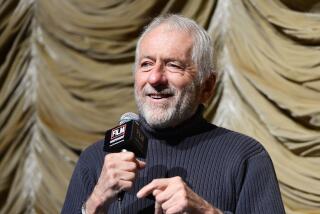SPREADING THE ‘MONEY’ AROUND : Massive Print Coverage of Newman-Cruise Film Comes as No Surprise: ‘Combinastion Is Irrestible to Editors.’ Says Newsweek’s David Ansen
- Share via
Paul Newman and Tom Cruise have been cropping up in all the right places lately.
Within the last month they have appeared either together or alone--blue and green eyes sparkling, respectively--on the covers of the New York Times Sunday magazine, Life, USA Today and scores of other newspapers around the country. Were it not for that hastily called summit in Iceland 12 days ago, they also would have owned the cover of Newsweek, giving them the rough equivalent of the Grand Slam of publicity for their new movie, “The Color of Money.”
This blizzard of media coverage for the movie comes as no accident. Newman, 61, and Cruise, 24, are two of Hollywood’s biggest stars, each commanding millions of dollars per role and each capable of selling tickets on marquee value alone.
They can sell magazines and newspapers too. Had the Newman-Cruise story held on as Newsweek’s cover story--the editors bounced Newman and Cruise inside the domestic edition but kept them on the cover of the international edition--it would have marked Newsweek’s first movie cover for 1986. “The Newman-Cruise combination is irresistible to editors,” says David Ansen, senior writer for Newsweek and the critic who wrote the cover-length story for the magazine.
On any movie there are those folks, known as publicists or “flacks,” whose job it is to make the cast of a movie irresistible to the media. In the case of “Money,” the assault on the press was comparable to the Chicago Bears famed “46 defense”: They seemed to be coming from everywhere. In addition to individual publicists for Newman, Cruise and director Martin Scorsese, the overall publicity was coordinated by Gary Kalkin, vice president of publicity for Walt Disney Pictures, a studio that clearly believes in blowing the publicity horns loud, clear and often.
That’s a lot of firepower for a movie that practically sells itself. (“The Color of Money,” released under Disney’s adult Touchstone Pictures banner, opened to extraordinary response. It earned an impressive $10,000 per screen at 635 theaters and grossed $6.4 million in its first weekend.)
“In this case, 1 and 1 (Newman and Cruise) add up to 5,” says a rival studio marketing executive. The massive exposure--a five-part series on “The Today Show,” a series on “Entertainment Tonight,” a coming Vanity Fair story, ad infinitum--raises a provocative and long-debated question: Can publicists sell movie tickets by hyping the press? And, can the major media be manipulated or do they simply choose to write about the movies they believe merit attention?
There are no simple answers. To the studios, movie journalism is seen as the very best kind of advertising: It’s cost-effective, and if a piece is positive, it reads like an objective endorsement of the movie. “You can’t buy Newsweek or Time; you can only lead them to the well and hope they drink,” says one studio executive who insists on anonymity.
Take the news-magazine cover story. Studios consider it the most coveted bauble in print journalism. A cover on Newsweek or Time goes out to millions of readers (Time has a slightly larger circulation) and is seen by millions more. (Both magazines have readerships in excess of 20 million.) Whether the story actually is read doesn’t matter to the movie makers. Says one studio publicist, licking his chops: “It (a news-magazine cover) is simply the most prestigious score. They don’t come along very often either.”
Last year Reagan forced a Clint Eastwood Newsweek cover inside when he was battling cancerous polyps. But the “Color of Money” had all the right ingredients--two blazing hot stars, a verbal director and the earmarks of blockbuster written all over it. According to Ansen, it didn’t take a publicist to show him and the Newsweek editors that this was probably the hit film of the fall season. “With that combination, you’d have to be an idiot not to think of it as a cover,” he said in a telephone interview.
But news-magazine covers are dicey. They may be the most deal-intensive area of big-league journalism. Covers require unusual “art”-- Life isn’t going to settle for the standard 8 x 10 glossies furnished by the studio. (For the Life cover, photographer Enrico Ferorelli placed the two actors in opposite directions lying atop Newman’s home pool table. In deference to fans of both stars, the western half of the country got Newman upside down and the eastern side--the dividing line was the Mississippi River--got Cruise upside down.) Hence, the negotiations begin: The studio executives may be excited about the prospects of a Time cover, but they want to make sure the writer (usually the magazine’s first-string critic) likes the movie. In general, the studio will agree to show an early version of the movie to a group of editors. Newsweek’s “back of the book” group saw a rough cut of “Money” in August. “Certainly, in a case like this, I would not want to do the story unless I liked the movie,” says Ansen.
But it doesn’t always work out that way.
Newsweek panned “The Great Gatsby” but ran it as a cover, and a cover story on impresario Robert Stigwood featured a nasty review of his movie, “Sgt. Pepper’s Lonely Hearts Club Band.” Similarly, Time’s 1982 cover on Paul Newman contained a less than enthusiastic review of “The Verdict,” while acknowledging the actor’s overall career contributions.
“Anything and everything you can use to bring attention to a movie helps,” says the marketing head of one studio. “But a cover is an implied endorsement by the publication. It says, this is an important movie.”
Another important and sensitive ingredient--and this is what makes the “Money” blitz so impressive--is the competition between journalistic organizations. As a policy, Newsweek does not follow Time, and locally, The Times rarely will run a story that has been done in competing local newspapers. (In this case, the Newsweek story, which ran a full two weeks before the opening of “Money,” beat out the Life spread.)
Even with the built-in media interest generated by Newman and Cruise, one wonders if “Money” would have received the same attention without the publicity troops. Newman rarely consents to interviews and veteran publicist Warren Cowan says he argued strongly with the actor to cooperate. Who convinced Newman to talk and pose for pictures? “In the case of the New York Times, I think I did, and in the case of Life, I think I did,” says Cowan. “But in the case of Newsweek, Jeff Katzenberg, chairman of Walt Disney Studios, called Paul and said how important it was.” (Katzenberg declined to comment for this story.)
The media are, by nature, skeptical. Inevitably there were those who suspected that Newman’s sudden cooperation signaled a greater plan to finally go after the best-actor Oscar that has eluded him for so many years. (He has been nominated six times and was awarded a special Academy Award last year for his body of work.) In a recent Times article, Cowan insisted that no campaign had been orchestrated: “If I were to suggest to Paul some kind of campaign, he’d hang up on me,” Cowan said.
Still, Cowan is not at all shy about the merits of Newman’s performance. “We will not be doing an Oscar campaign on Paul,” says Cowan. “But if I were a betting man, I’d be willing to make a big wager that he not only will be nominated, but he stands an excellent chance to win.”
More to Read
The biggest entertainment stories
Get our big stories about Hollywood, film, television, music, arts, culture and more right in your inbox as soon as they publish.
You may occasionally receive promotional content from the Los Angeles Times.










